 Kawasaki Z1000SX - Service manual > Service Code Clearing Procedures
Kawasaki Z1000SX - Service manual > Service Code Clearing Procedures
- Start the service code erase mode with the following procedure.
- The erase mode starts when the ABS self-diagnosis terminal is disconnected from the ground terminal after starting the self-diagnosis mode.
- The service code can be erased by grounding and ungrounding (each time for at least one second) the ABS self-diagnosis terminal three times within about 12.5 seconds after starting the erase mode.
- The ABS indicator light (LED) remains lit during the erase mode.
- After erasing, the ABS indicator light (LED) blinks and lights.
- Once erasing is finished, enter the self-diagnosis mode again to confirm that the service codes have been erased. If the ABS has been reset and all codes have been erased, only start code 12 will be shown.
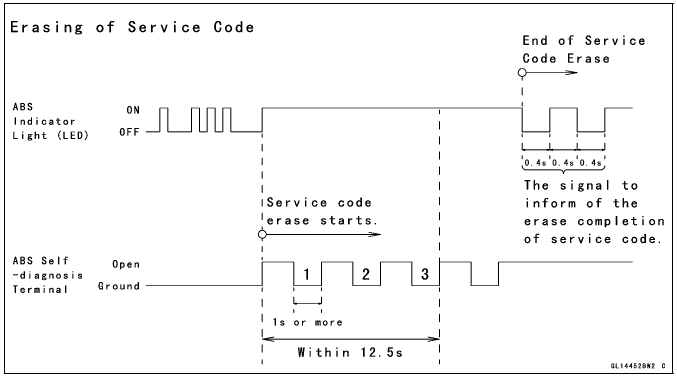
Self-diagnosis Flow Chart
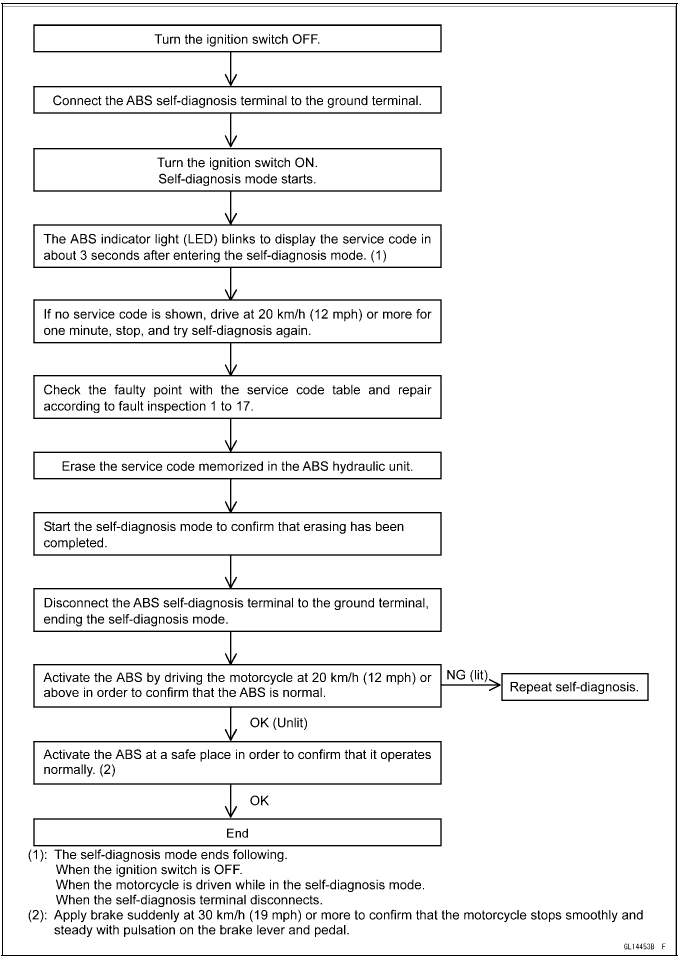
How to Read Service Codes
- Service codes are shown by a series of long and short blinks of the ABS indicator light (LED) as shown below.
- Read 10th digit and unit digit as the ABS indicator light (LED) blinks.
- When there are a number of faults, a maximum of all service codes (17 codes) can be stored and the display will begin starting from the small number code entered.
- For the display pattern, first the smallest number code is shown, next up to all service codes (17 codes) starting with the last one stored, then the display is repeated from the smallest number code once again.

- If there is no fault, the ABS indicator light (LED) lights as shown in the figure.
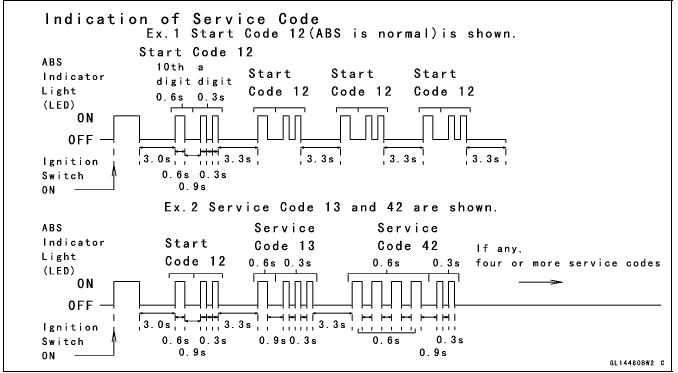
How to Erase Service Codes
- Even if the ignition switch is turned OFF, the battery or the ABS hydraulic unit are disconnected, all service codes remain in the ABS hydraulic unit.
- Refer to the Service Code Clearing Procedure for the service code erasure.
Service Code Table
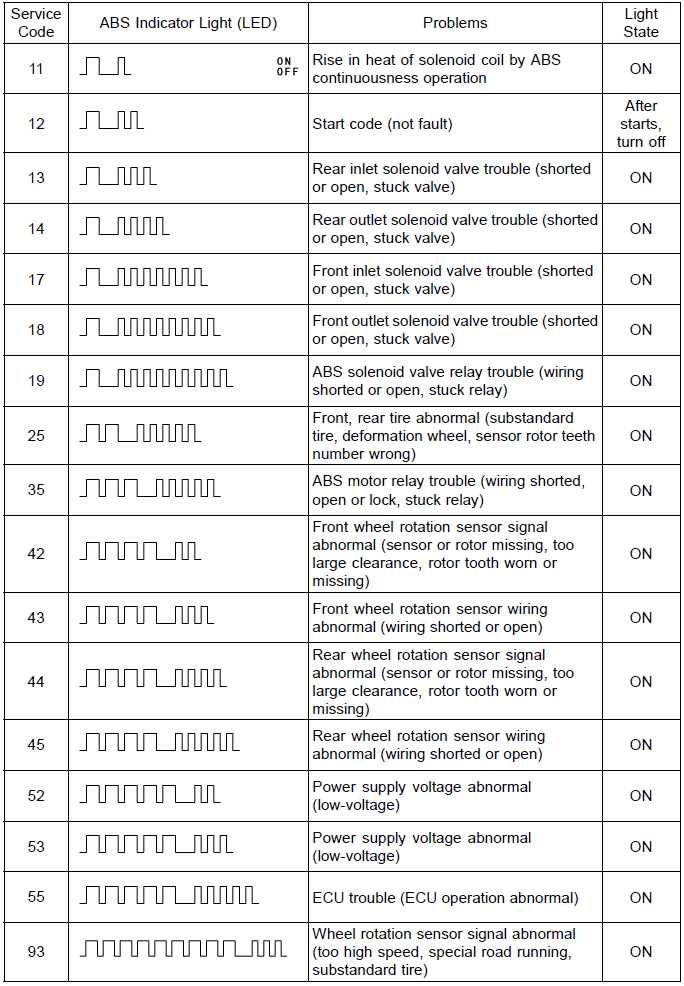
ABS Indicator Light (LED) Inspection
- In this model, the ABS indicator light (LED) [A] goes on or blinks by the control of the ABS hydraulic unit.
- Turn the ignition switch ON.
If the ABS indicator light (LED) lights, it is normal.
If the ABS indicator light (LED) does not light, refer to the Meter Unit Inspection in the Electrical System chapter.
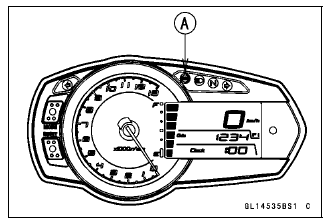
If the meter is good, check the wiring continuity of the BK/W lead in the main harness.
Special Tool - Hand Tester: 57001-1394
Wiring Continuity Inspection
Meter Connector [A] ← → ABS Hydraulic Unit Connector [B]
BK/W Lead [C]
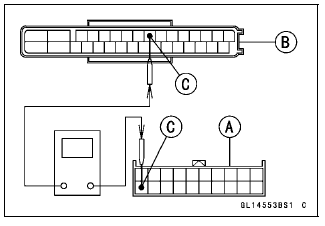
If there is not the continuity in the lead, replace or repair the main harness.
If there is the continuity in the lead, replace the ABS hydraulic unit.
Solenoid Coil Temperature Abnormal [High-Temperature] (Service Code 11)
- When the temperature of the solenoid coil rises more than a prescribed value by the ABS continuousness operation, this service code is detected. Therefore, check it after leaving the motor cycle for tens of minutes or more.
- Recheck the service code indication; erase the service code, perform the
pre-diagnosis inspection 1 and 2, and retrieve the service code.
If the ABS indicator light (LED) [A] lights, the ABS hydraulic unit has trouble. Replace the ABS hydraulic unit.
If the ABS indicator light (LED) does not light, ABS system is normal (service code is not stored; temporary failure.).
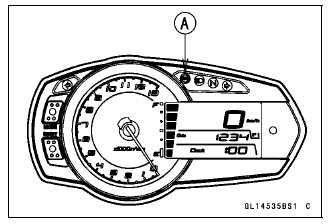
Solenoid Valve Inspection (Service Code 13, 14, 17, 18)
- Recheck the service code indication; erase the service code, perform the
pre-diagnosis inspection 1 and 2, and retrieve the service code.
If the ABS indicator light (LED) [A] light, the solenoid valve in the ABS hydraulic unit has trouble. Replace the ABS hydraulic unit.
If the ABS indicator light (LED) does not light, ABS system is normal (service code is not stored; temporary failure.).
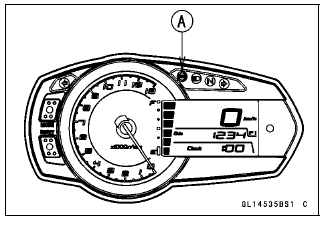
ABS Solenoid Valve Relay Inspection (Service Code 19)
- Remove:
Front Seat (see Front Seat Removal in the Frame chapter) - Check the ABS solenoid valve relay fuse (20 A) [A] (see Fuse Inspection in the Electrical System chapter).
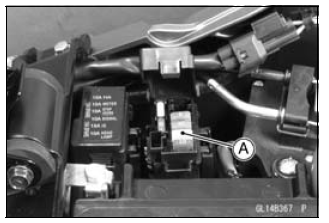
If the fuse is good, check the wiring continuity that relates to the LG lead in the main harness referring to the ABS System Wiring Diagram.
Special Tool - Hand Tester: 57001-1394
Wiring Continuity Inspection
ABS Hydraulic Unit Connector [A] ←→ Fuse Box Terminal [B]
LG Lead [C]
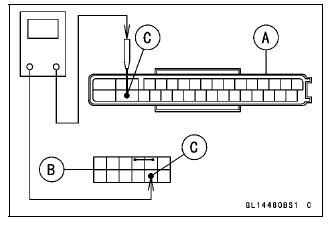
If there is not the continuity in the lead, replace or repair the main harness.
If there is the continuity in the lead, go to next stemp.
- Recheck the service code indication; erase the service code, perform the
pre-diagnosis inspection 1 and 2, and retrieve the service code.
If the ABS indicator light (LED) [A] lights, the ABS hydraulic unit has trouble. Replace the ABS hydraulic unit.
If the ABS indicator light (LED) does not light, ABS system is normal (service code is not stored; temporary failure.).
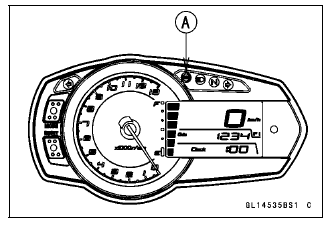
See also:
 Kawasaki Z1000SX - Service manual > Inquiries to Rider
Kawasaki Z1000SX - Service manual > Inquiries to Rider
Each rider reacts to problems in different ways, so it is important to confirm what kind of condition the rider is dissatisfied with. Try to find out exactly what problem occurs under exactly what conditions by asking the rider; knowing this information may help you reproduce the problem in the shop. The diagnosis sheet will help prevent you from overlooking any keys, so always use it.
 Kawasaki Z1000SX - Service manual > Front, Rear Wheel Rotation Difference Abnormal (Service Code 25)
Kawasaki Z1000SX - Service manual > Front, Rear Wheel Rotation Difference Abnormal (Service Code 25)
Check the following and correct the faulty part. Incorrect Tire Pressure Tires not recommended for the motorcycle were installed (incorrect tire size). Deformation of Wheel or Tire Missing Teeth and Clogging with Foreign Matter of Sensor Rotor (see Wheel Rotation Sensor Inspection)
 Rider's Manual BMW R 1250 GS GSA
Rider's Manual BMW R 1250 GS GSA Owner's Manual Harley-Davidson Sportster XL1200X Forty-Eight
Owner's Manual Harley-Davidson Sportster XL1200X Forty-Eight Owner's Manual Honda CBR650R
Owner's Manual Honda CBR650R Service manual Honda CBR650
Service manual Honda CBR650 Owner's Manual Honda PCX125
Owner's Manual Honda PCX125 Owner's Manual Kawasaki Z1000SX
Owner's Manual Kawasaki Z1000SX Service manual Kawasaki Z1000SX
Service manual Kawasaki Z1000SX Owner's Manual Lexmoto Echo
Owner's Manual Lexmoto Echo Owner's Manual Royal Enfield Interceptor 650
Owner's Manual Royal Enfield Interceptor 650 Service manual Royal Enfield Interceptor 650
Service manual Royal Enfield Interceptor 650 Owner's Manual Yamaha MT-07
Owner's Manual Yamaha MT-07